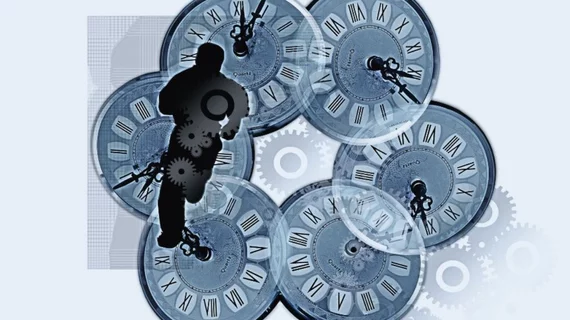Under pressure: 72% of interventional radiologists experience burnout
Burnout is high among interventional radiologists, according to a new study published in the Journal of Vascular and Interventional Radiology. Researchers categorized this statistic as “an alarming finding.”
“Likely owing to the complex personal and organizational factors that contribute to career-related stress, studies have found varying rates of burnout among physicians in different specialties,” wrote Jacob J. Bundy, MD, MPH, department of radiology at the University of Michigan Health System in Ann Arbor, and colleagues. “Whereas burnout has been studied among practicing diagnostic radiologists, burnout among interventional radiologists has not been characterized.”
Bundy et al. aimed to correct that omission by developing a 34-question survey for representatives from the specialty, with 22 of those questions coming from the Maslach Burnout Inventory-Human Services Survey (MBI). The team received 339 complete responses from Jan. 7 to Feb. 6, 2019. Demographic data of the respondents found that 77.6% were male and 44.2% were between the ages of 30 and 39, making it the most common age group. Also, 87.9% of respondents were attending interventional radiologists, 6.2% were residents and 5.9% were fellows.
Overall, 71.9% of respondents reported experiencing burnout. According to the MBI portion of the survey, 61.9% of respondents were at a high risk of emotional exhaustion and 54.3% were at a high risk of depersonalization.
“Interventional radiologists report manifestations of burnout at a rate higher than not only the general public (28%), but also diagnostic radiologists (54%–61%) and surgeons (40%),” the authors wrote. “The technical challenges, physical demands, and unpredictable work hours of interventional radiology likely impart different stressors, and thus rates of burnout may be related to these factors. Regardless, this is an alarming finding given the negative impact burnout has on job satisfaction, career longevity, mental health and patient care.”
Also, female interventional radiologists and specialists who work more than 80 hours per week were “significantly associated” with experiencing burnout.
“Gender judgment and stereotypic perceptions of female physicians have been linked to increased rates of burnout and worsened psychological well-being,” the authors wrote. “These findings suggest that increasing the number of women in a predominantly male-dominated field, such as interventional radiology, may mitigate the relationship between stereotypic perceptions and burnout among women.”
The team’s survey also included an optional, open-ended question at the end about the “greatest contributor to burnout in the workplace.” The answers—received from 76.1% of respondents—included “administrative pressures on productivity and administrative tasks, relationships between interventional radiologists and ancillary staff, workload and work hours, electronic medical record and documentation systems, diagnostic radiology responsibilities, contentious relationships with diagnostic radiologists within the same practice, lack of recognition and respect from other medical and surgical subspecialties, and fielding inappropriate consultations from other medical professionals.”
Working to identify and reduce burnout among interventional radiologists, the authors concluded, is “essential” and the industry needs strategies to accomplish those goals.

